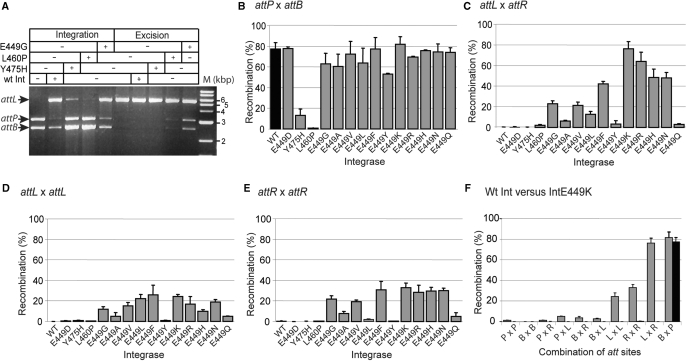Figure 1.
In vitro recombination with the hyperactive integrases. (A) Detection of recombination products by restriction analysis and agarose gel electrophoresis. Standard recombination conditions were applied and the reactions were digested with HindIII to detect integration and excision products. The product of integration, pRT602700, gave two fragments, 5435 bp (attL) and 91 bp (attR; data not shown), resulting from the fusion of the substrates, 3034 bp (pRT700, attP) and 2513 bp (pRT602, attB). For the excision reaction pRT602700 was used as a substrate. After HindIII digestion, the presence of the 3034 bp (attP) and 2513 bp (attB) indicated excision had occurred. The extreme right-hand lane contains molecular weight markers. (B–F) Quantitative in vitro recombination assays of Int mutants (grey bars) compared to wt Int (black bars). Recombinants were detected indirectly by excision of lacZ or lacZα flanked by two att sites using the following substrates: (B); attB x attP (pRT508), (C) attL x attR (pMSX18), (D), attL x attL (pMSX34) and (E), attR x attR, (pMSX36). Substrates were incubated with integrase and then introduced into DH5α by transformation. The percentage of white colonies obtained for each integrase is shown. (F) Activities of Int E449K and wt Int on all possible combinations of att sites using the following substrates; P × P (attP x attP; pMSX22), B × B (attB x attB; pMSX32), P × R (attP x attR; pMSX30), P × L (attP x attL; pMSX24), B × R (attB x attR; pMSX28), B × L (attB x attL; pMSX26), L × L (attL x attL; pMSX34), R × R (attR x attR; pMSX36), L × R (attL x attR; pMSX18) and B × P (attB x attP; pRT504). The data are the average and standard error for two replicates.

